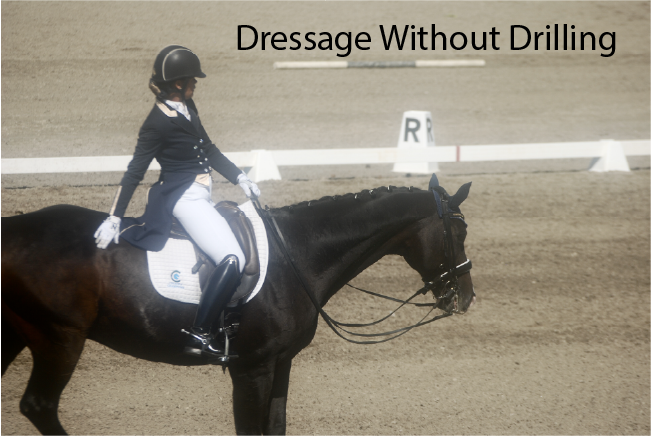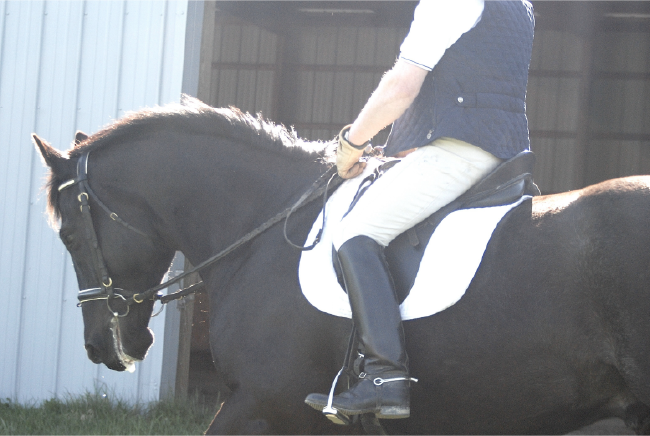Dressage Without Drilling
By Nikki Alvin-Smith

Dressage is not all about going around in circles, even if it feels like it at times. One of the enemies of progress for horse and rider is boredom. A bored horse will not be a forward moving horse and may even shut down listening to his rider altogether if his mental health is not taken into consideration. Everyone needs a refresh and reboot from both the environmental standpoint and the riding surface standpoint.
It is almost inevitable that ambitious riders and horse trainers will experience long periods of indoor work only. It becomes a necessary part of the regimen when you live year round in the North-East USA. Obviously not every dressage rider has access to an indoor riding arena but that doesn’t mean work cannot continue throughout winter days if an outdoor space is available. Think outside the box! Both snow and sand can make super riding surfaces to practice everything from passage to expressive canter work.
It’s also very important that both horse and rider are mentally and physically challenged and encouraged to step out of their comfort zone to keep them engaged in the learning process.
Drilling your dressage horse is a recipe for disaster. Not only does it do the opposite of the gymnastic building of the musculature of the horse that dressage is all about, it also numbs the horse to the aids and dulls his mental acuity. Drilling a horse can even result in physical damage and negatively affect his biomechanical talents and capacity on a permanent basis.
Similarly riders can become sore and locked up in their hips, arms and backs without varied work.
A balanced approach is essential to successfully training your horse in any discipline, and that means working inside and out, uphill and down, in open fields and winding forest trails. Wherever you are, you can still work on your dressage training and can do so with success.
Here are a few simple points to consider when training your dressage horse to help you think outside the box.
Building Blocks of Dressage – A, B, C’s
A pre-requisite for basic dressage training is the horse must be ridden forward. This doesn’t mean rushing about out of cadence and rhythm, but the horse moving from back to front without interruption of his back’s movement by the rider’s seat or being repetitively banged on his side by the pounding of leg aids, or even worse a permanently gripping calf and thigh and kicking heel.
Horses have a knack of conning less experienced riders into the belief that just because their head is down and they are yielding to the bit, that they are moving correctly from the back and not in two parts. It feels comfortable to the rider but in fact it is not dressage.
When you take most horses will naturally energize themselves when you take them outside the confines of a ring and work them on a rolling hill in an open field. This enables the rider to feel when their mount is properly moving from behind and not faking it, especially if working on a slight incline.
A horse cannot be truly straight unless he is forward. Once outside the confines of a ring, the absence of indoor arena wall or arena fence also means there is no magnetic force from the outside of the ring drawing the horse to the side and it is easy to tell if the horse is straight and takes even pressure in both reins.
If you think you’ve mastered lateral work with your horse, ride him outside in a large open space. You will soon know how much your horse is working off your aids and how much he is truly in your hand rather than working off your seat bones and weight aids.
All training aspects of dressage can be mastered on a 20-meter circle as proven in history by countless trainers. However, who wants to do that! It is much more fun to practice your half-halts and stride length on the trail, and elevate the engagement of his piaffe on the beach.

Ride With Company
It is always good to take a riding buddy when you head out on the trail for both safety reasons and for fun. If your accompanying horse and rider combination are more experienced in dressage than your equine partner and yourself, this is a perfect opportunity to garner some useful help in your dressage work.
For example, a horse learning the baby steps of piaffe, will emulate the piaffe action of a horse next to it and sit down and collect. The vantage point of riding alongside you is a great help to your trainer, as they can easily view your use of training aids.
Of course as horses do copy behavior from each other be careful that your companion duo are well-behaved.
Mix It Up
It is impossible to make a horse or rider supple without bending in both directions and switching between both directions to stretch and contract the ligaments, tendons and muscles of both horse and rider.
The horse’s back must similarly by developed for dressage with lengthening and collecting of the spine and its structural components. You cannot train a dressage horse successfully by wandering about the arena in a permanent passage or build the necessary strength and muscle development required for a pirouette by walking in tight circles or cantering on endlessly on the spot.
The reason you hear so much about advanced riders being told to return their horses to basic training is as much for their benefit as for the horses’ benefit. Crooked work, repetitive movements, compression instead of collection all result from the overzealous trainer who believes that repeating something over and over is the best way to train the horse. Drill it in to him! It doesn’t work. Horses simply don’t learn that way. It is well worth reading up on the subject of how horses do learn and how horses’ think. There are a myriad of fabulous books on the topic.
Take Home Message
Monotony is no way to live life and no way to train a horse. Be sure you don’t lose your horse’s passion for dressage because you’ve drilled it out of him.
About the author: Nikki Alvin-Smith is a professional freelance writer and content creator, who works with a variety of publications and manufacturers worldwide. She is a British international Grand Prix dressage trainer/clinician who has competed in Europe at the Grand Prix level earning scores of over 72%. Together with her husband Paul, who is also a Grand Prix rider, they operate Willowview Hill Farm, a private horse breeding/training farm in Stamford, NY. Please visit her website at https:/www.nikkialvinsmithstudio.com to learn more.



